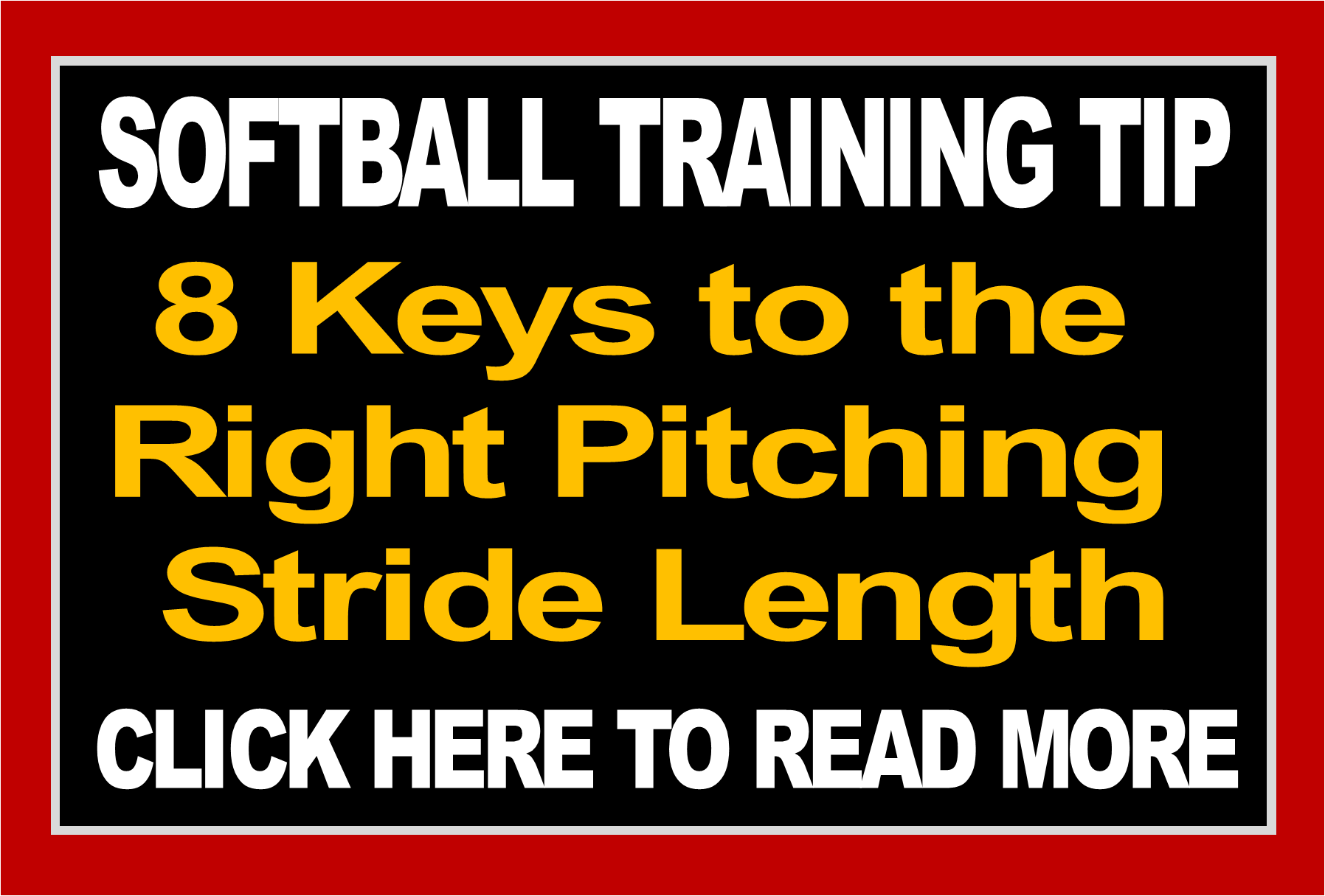
01 Feb 8 Keys to the Right Pitching Stride Length
I come across lots of people who tell pitchers to take a little stride, others try to take a humongous one, while some others have no clue.
Read on to discover what you really should be telling your pitchers when it comes to their stride.
Before we talk stride length, let’s first agree on what we use our stride for. In this discussion, I’m not talking specifically about pitching. We stride when we throw overhand – catcher’s stride on throws to the pitcher and down to bases, infielders and outfielders stride on their throws, and baseball pitchers stride as well.
So what purpose does our stride serve?
- Balance – our stride helps our bodies. We walk around with our upper bodies generally over our lower bodies. Whenever this gets out of whack – either the upper body going too far past our lower, or lower too far beyond our upper – then we fall. You can’t throw or pitch if you’re falling, so your stride helps you keep your balance, and allows you to complete your pitch or throw.
- Power – as a result of balance, we can use our feet based on how we plan to use our upper body. For instance, if we’re making a really short throw we don’t need much upper body so we won’t involve much lower body in the way of a stride. But, if suddenly we have to throw out a runner at home, or nail someone stealing 2nd, or fire a pitch past a hitter holding a metal weapon then our upper body is going to be flying forward with a lot of power and force which will require our lower body to end up underneath our upper body when it’s release time…or else we lose our balance, fall and blow the throw. And it’s the stride that determines where our lower body goes.
- Possible Direction – some will say that the stride is involved in direction, but I have to argue this one as you can make a throw to any location without even taking a step, you just can’t make it very fast or very far. This is what brings me back to believing that the stride is really needed for Balance and Power, and that Direction is a result of Balance.

So, with that said let’s look at some examples of a powerful stride. Above you’ll find 3 players doing 3 different skills: an outfielder throwing home, a catcher throwing to 2nd base, and a pitcher mid-pitch. While all 3 play different positions, they’re all trying to do the same thing, and that is throw the ball with as much speed and force as possible. You’ll notice that all 3 are using their feet – and particularly their stride – very powerfully. The rule of thumb is the more powerful the throw, the more powerful the stride. The lower body must end up under the upper body and in anything powerful, the upper body is being required to do a lot so the stride will do a lot as well.

If you’re still not so sure then let’s look at the opposite of a powerful and explosive throw, and that’s a close and easy toss from an infielder or a pitcher doing her snaps. In both, the objective isn’t power or distance but touch and softness. As a result, each player needs very little from her upper body, so she requires virtually no stride.
Now, let’s talk about striding at it relates to a pitcher. I think we can all agree that a pitcher falls into the explosive upper body category, which also means she needs an explosive lower body. Before we get too far into that, lets look at what all pitchers have in common when it comes to their stride:
- They have good balance and direction
- They stride as far as they can while maintaining good mechanics and balance
- They all glide prior to the stride foot planting
In softball, we get into disagreements about a pitcher’s stride length, while baseball has a general rule that says a pitcher’s stride is generally between 70 to 90% of their height. Please know that this is NOT a percentage that is written in stone and that you shouldn’t pull out your tape measures and start measuring height and stride length! This article is meant as a mind starter to trigger your brain to start delving deeper into what people just arbitrarily say about various pitching mechanics to see if they seem logical and real before we pass them on to our pitchers. Sounds fare enough, doesn’t it? Ok, then on we go…
Let’s see how much truth there is to this and if a rule like this might actually apply to softball. The following pictures, using Dartfish software, show a baseball pitcher imposed over a softball pitcher and will really help us discuss stride length using more fact than fiction (and fiction is unfortunately what istoo often used when teaching softball pitchers).

If we look from left to right at the 4 picture sequence above we can see that while both pitchers don’t start at the same location (we’ll get to this in a minute) they do finish at exactly the same place on their stride. Interesting, isn’t it?

To see if this 70 to 90% of height rule really applies to the stride we must start by measuring the stride length of both pitchers. We find the baseball pitcher taking a 5 ft 2 inches stride while the softball pitcher strides 7 feet. Before you think 7 feet is ridiculous for a pitcher hang in there and bear with me for a bit. When we compare these two stride lengths to the height of each pitcher (which we see in the picture below) we find that the baseball pitcher is 6 feet tall and the softball pitcher is 5 feet 9 inches.
For baseball the calculations end here, so we can use a 6 foot tall pitcher taking a 5 foot 2 inch stride to determine that his stride is 86% of his height – falling right into the 70 to 90% region.

While this ends the baseball pitcher’s calculations it isn’t that easy to determine our softball pitcher’s stride length due to something I call the Glide Factor. Go back up to the 4 photo baseball-softball overlay series and look closely at the first and the fourth pictures. You’ll see that both pitchers land at the same place in their stride yet they don’t start at the same place. The softball pitcher starts further back than the baseball pitcher and yet ends up at the same location. You could say that’s because she strides so much longer, which might seem true if you only looked at the end of her stride – 7 feet. Think about that for a minute – the softball pitcher is only 5 feet 9 inches and takes a 7 foot stride while a 6 foot tall baseball pitcher strides only 5 feet 2 inches? Crazy huh, something doesn’t seem to make sense.
Well that something is the Glide Factor. Baseball pitchers start up on a hill so they get the advantage of gravity and force adding power to their stride as they step downhill. But softball pitchers have no such hill and must start on flat ground to create the same amount of explosion and power as their baseball cohorts.
To get this explosion and power a softball pitcher will blast her stride out forward and before her stride foot hits the ground she’ll actually glide for a couple feet. This glide isn’t something you practice it’s much more the result of the explosive lower body action, like what an outfielder experiences making that long throw home from the outfield fence. As a note, this Glide Factor is seen more easily and more obviously on a video than still photos.

In looking at our baseball-softball Dartfish overlay we can see the softball pitcher has a Glide that’s 2 feet 3 inches long. Ok, trust me when I tell you I’m in NO way a math whiz so I am NOT trying to make all of this sound complicated – and please forgive me if I’ve already done that. But I also think it’s VERY important that we teach what really happens and not what either we just think happens or what other people have told us happens.
In order to accurately figure out the softball pitcher’s real stride length we need to subtract her Glide from her Stride which means 7 feet minus 2 ft 3 inches ends up being a measurable stride of 4 feet 9 inches. Stay with me here… A 5 ft 9 inch pitcher taking a 4 foot 9 inch stride makes her stride 82% of her height! That falls into the 70 to 90% factor that baseball talks about which I find really interesting.

But to me, I need to run all this madness past the stride length of one of our game’s best pitchers – Cat Osterman. Let’s take a quick look at Cat’s stride and glide length and see how a world class pitcher falls into our discussion. Looking at the picture to the left shows that Cat takes a 7 foot 5 inch stride. While this number seems insane check out how close her stride foot lands to the circle which is 8 feet from the pitching rubber. Yet, when you look at Cat’s landing position she doesn’t seem out of balance or out of control. You would think anyone taking just about a 7 ½ foot stride would be completely out of control and yet Cat has her feet underneath her and is under control and balanced.
This balanced look at release that Cat has, while taking a 7 ½ foot stride (approx) is possible because of the Glide Factor. By a pitcher actually gliding during her stride she’s able to cover so much more ground and she generates a tremendous explosion for her hand to use at release. This Glide is again something the pitcher does before her stride foot hits the ground traveling her forward while the toes of her back foot are in contact with the ground.

Looking at Cat’s Glide Factor we can see she has a 2 foot 6 inch glide. When you remove that glide length from her total stride (7 ft 5 in) it leaves her with a stride of 4 feet 11 inches. And, knowing that Cat is 6 feet 2 inches tall it means that Cat’s 4 ft 11 in stride is 79% of her height – again falling into our 70 to 90% range.
Hopefully I haven’t bored you to death with too much math. If you happen to be a current student-athlete reading this, I hope it serves as a useful reason to pay attention in math class.
Anyway, I didn’t go into this whole thing with a preconceived notion of what I wanted to find but rather was just curious to see what was actually happening. To sum up, here are some things we should pay attention to when talking about a pitcher’s stride:
- You don’t want to jump out of control when you stride just to add a foot to your stride.
- You want to push off the ball of your pivot foot to help get maximum power.
- Don’t jeopardize your pitching mechanics at the expense of gaining distance.
- Let your feet help your hand – remember it isn’t the pitching long jump!
- Younger pitchers who are still developing their pitching fundamentals and confidence won’t have much of a glide factor since they won’t tend to be as explosive as a more powerful pitcher.
- Use the stride when pitching underhand the same way you do when throwing overhand – the more powerful the throw the more explosive the stride
- The stride only starts the pitch, the hand finishes it!
- The pitcher must end up balanced and over her stride foot in the follow-through and not falling either backwards and short of her stride or else forward and beyond her stride. In either of these cases the stride was either too long (if falling backwards) or else too short (if falling forward beyond the stride)
Both softball and baseball pitchers use their strides as means to create power, explosion and balance. The stride is simply the start of the pitch and not the finish so while it does appear softball pitchers actually stride within the same 70 to 90% distance of their height it DOESN’T mean we should all head out to the bullpens with our tape measures and start creating robots. Use more of your body-motion common sense when teaching pitchers – notice how players use their upper and lower bodies while doing other skills and motions. If what you’re teaching someone in pitching wouldn’t seem logical when throwing overhand, then chances are, it’s crazy underhand.
Written by Coach Cindy Bristow of Softball Excellence.




